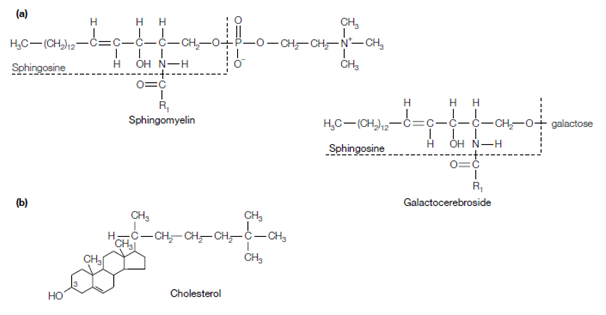Sphingolipids
Sphingomyelins, the general sphingolipids have a sphingosine backbone that is shown in figure in place of the glycerol in glycerophospholipids. Such as the glycerophospholipids, Sphingomyelins also have a phosphorylated headgroup either choline or ethanolamine and two hydrocarbon chains. One is a fatty acid as found in the glycerophospholipids the other is hydrocarbon chains comes from the sphingosine molecule, except which it is bonded through an amide bond in sphingolipids. They are present in the plasma membrane in the most of cells.

Figure: Structures of (a) the sphingolipids sphingomyelin and galactocerebroside; (b) cholesterol. R1 represents the hydrocarbon chain of fatty acids.
and are particularly abundant in the myelin sheath which surrounds nerve cells. The glycosphingolipids like as the gangliosides and cerebrosides are also consequential from sphingosine but in place of the phosphorylated headgroup they have one or more sugar residues. Galactocerebrosides have a single galactose residue and are found predominantly in the neuronal cell membranes of the brain. The gangliosides have various sugar residues involving at least one sialic acid (N-acetylneuraminic acid) residue and are a main constituent of most mammalian plasma membranes being particularly abundant in the brain cells. Lipid composition of the chloroplast thylakoid membranes in plant cells is highly distinctive: about 40 percent of the total lipids are galactolipids and 4 percent sulfolipids, with only 10 percent being phospholipids.